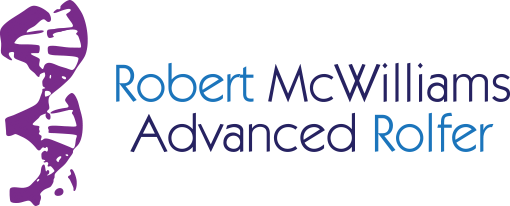In a previous post, I wrote:
“End feel, sensitivity to layers, functional and anatomical knowledge are necessary to couple with knowledge of techniques to release fixations, in the appropriate sequence, and then integrate.”
Sensitivity to layers refers to the different layers of fascia around areas of the body, and also around a specific joint. Sequencing, as referenced above, can also refer to layers of tissue, but also to the body’s process of responding to the intervention. One of the main premises of Rolfing® Structural Integration (SI) is that it is important to not only deal with an area that is restricted, but to feel, analyze, see, and address all other “pulls” on that part of the system. Fascia can lay out in sheaths or sheets in the body, and in optimal motion they glide over each other and anchor muscle to move bone. Problems result when, because of accidents or a constantly held posture, the glide between layers is lost, and adhesions, sometimes really large, sometimes small, can make the layers ‘stick’ together. Frequently, this can be about superficial layers helping to keep deeper layers in a restricted position. For that reason, even if there is a restriction in a deeper structure, perhaps very close in around a joint, the superficial layers must be addressed, and sometimes from a point far away from the ‘primary issue’ in a deeper layer. Too, nerve inflammation or restriction can be a source of irritation in an area, and many times these are best addressed in a very superficial layer of fascia.
There is a good reason for the use of the word ‘integration’ in relation to this work. The goal of the work is improvement, as expressed and experienced by you, the client. Once the ‘stuck’ places and previously adhesed layers have been freed up, for these changes to last ( and thus ‘integrated into their body maps-ok, more on that later!) people need to bring the changes into awareness, more often than not through movements like walking, reaching, rolling, arching, curling and twisting to name a few. While these movements are also good for establishing stability and supple responsiveness in the body, they are also critical to this ‘integrative’ process of ‘making change our own’ and thus hanging onto it better.
This transition from an improvement in the system-wide ‘glide’ between tissues to a new ‘full-bodied awareness’ for the client is not always as easy as it might seem, because it is a shift in how we feel about our bodies and ourselves. More than just “my shoulder feels better”, something about the way the rest of us feels in relation to that previously aggrieved shoulder has changed. Often times it is hard to say, or even know, what that is. Being better able to feel and express ‘what shifted’ in these situations is a hallmark of deep change and integration, in my opinion. This kind of noticing what happens inside of us, with pleasure and amazement, helps make the journey of life richer, and sometimes, hardships and setbacks easier to bear. It is the opposite of Nietzsche’s famous ‘that which does not kill me makes me stronger’ (which could also read: ‘that which does not kill me may warp me for life’!) Perhaps, then, Rolfing SI’s similar tag-line could be: “That which makes me more joyous and resilient makes me stronger AND happier!”
